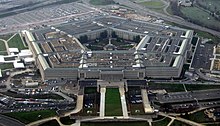Northern Virginia

Tysons is the principal economic hub of Fairfax County, the most populous county in Northern Virginia.

Northern Virginia counties.
Northern Virginia – locally referred to as NOVA– comprises several counties and independent cities in the Commonwealth of Virginia in the United States. It is a widespread region radiating westward from Washington, D.C. With 2.8 million residents (about a third of the Commonwealth), it is the most populous region of Virginia and the Washington metropolitan area.[1][2][3]
Communities in the region form the Virginia portion of the Washington metropolitan area and the larger Baltimore-Washington metropolitan area. Northern Virginia has a significantly larger job base than either Washington or the Maryland portion of its suburbs,[4] and is the highest-income region of Virginia, having several of the highest-income counties in the nation.[5]
Northern Virginia's transportation infrastructure includes major airports Ronald Reagan Washington National and Washington Dulles International, several lines of the Washington Metro subway system, the Virginia Railway Express suburban commuter rail system, transit bus services, bicycle sharing and bicycle lanes and trails, and an extensive network of Interstate highways and expressways.
Notable features of the region include the Pentagon and the Central Intelligence Agency, and the many companies which serve them and the U.S. federal government. The area's attractions include various monuments and Colonial and Civil War-era sites such as Mount Vernon and Arlington National Cemetery.
Etymology
HistoryEdit
Colonial periodEdit

Map of the Northern Neck Proprietaryland grant c. 1737
Historically, in the British Colony of Virginia first permanently settled at Jamestown in 1607, the area now generally regarded as "Northern Virginia" was within a larger area defined by a land grant from King Charles II of England on September 18, 1649, while the monarch was in exile in France during the English Civil War. Eight of his loyal supporters were named, among them Thomas Culpeper.[11]
On February 25, 1673, a new charter was given to Thomas Lord Culpeper and Henry Earl of Arlington. Lord Culpeper was named the Royal Governor of Virginia from 1677–1683. Culpeper County was later named for him when it was formed in 1749; however, history does not seem to record him as one of the better of Virginia's colonial governors. Although he became governor of Virginia in July 1677,[12] he did not come to Virginia until 1679, and even then seemed more interested in maintaining his land in the "Northern Neck of Virginia" than governing. He soon returned to England.[13] In 1682 rioting in the colony forced him to return, but by the time he arrived, the riots were already quelled. After apparently misappropriating £9,500 from the treasury of the colony, he returned to England and the King was forced to dismiss him. During this tumultuous time, Culpeper's erratic behavior meant that he had to rely increasingly on his cousin and Virginia agent, Col. Nicholas Spencer.[14][15] Spencer succeeded Culpeper as acting Governor upon Lord Culpeper's departure from the colony. For many years, Lord Culpeper's descendants allowed men in Virginia (primarily Robert "King" Carter) to manage the properties.[16]
Legal claim to the land was finally established by Lord Culpeper's grandson, Thomas Fairfax, 6th Lord Fairfax of Cameron, who became well known in the colony as "Lord Fairfax", in a survey authorized by Governor William Goochin 1736.[citation needed] The lands of Lord Fairfax (and Northern Virginia) were defined as that between the Rappahannock and Potomacrivers, and were officially called the "Northern Neck".[17] In 1746 a back line was surveyed and established between the headwaters of the Potomac and Rappahannock rivers, defining the west end of the grants. According to documents held by the Handley Regional Library of the Winchester–Frederick CountyHistorical Society, the grants contained 5,282,000 acres (21,380 km2). They included the 22 modern counties of Northumberland, Lancaster, Westmoreland, Stafford, King George, Prince William, Fairfax, Loudoun, Fauquier, Rappahannock, Culpeper, Madison, Clarke, Warren, Page, Shenandoah, and Frederick counties in Virginia, and Hardy, Hampshire, Morgan, Berkeley, and Jefferson counties in West Virginia.[18]
Lord Fairfax was a lifelong bachelor, and became one of the more well-known persons of the late colonial era. In 1742 the new county formed from Prince William County was named Fairfax County in his honor, one of numerous place names in Northern Virginia and West Virginia's Eastern Panhandle which were named after him.[19] Lord Fairfax established his residence first at his brother's home at "Belvoir" (now on the grounds of Fort Belvoir in Fairfax County).[16]
Not long thereafter, he built a hunting lodge near the Blue Ridge Mountains he named "Greenway Court",[11] which was located near White Post in Clarke County, and moved there. Around 1748 Lord Fairfax met a youth of 16 named George Washington, and, impressed with his energy and talents, employed him to survey his lands lying west of the Blue Ridge.[11]
Lord Fairfax stayed neutral during the American Revolutionary War. Just a few weeks after the surrender of British troops under General Cornwallis at Yorktown, he died at his home at Greenway Court on December 9, 1781, at the age of 90. He was entombed on the east side of Christ Church in Winchester.[16] While his plans for a large house at Greenway Court never materialized, and his stone lodge is now gone, a small limestone structure he had built still exists on the site.[11]
Statehood, Civil WarEdit

Mount Vernon, the plantation home of George Washington
Following the American Revolutionary War, when the thirteen colonies formed the United States of America, war hero and Virginian George Washington was the choice to become its first president. Washington had been a surveyor and developer of canals for transportation earlier in the 18th century. He was also a great proponent of the bustling port city of Alexandria, which was located on the Potomac River below the fall line, not far from his plantation at Mount Vernon in Fairfax County.
With his guidance, a new federal city (now known as the District of Columbia) was laid out straddling the Potomac River upon a square of territory which was ceded to the federal government by the new states of Maryland and Virginia. Alexandria was located at the eastern edge south of the river. On the outskirts on the northern side of the river, another port city, Georgetown, was located.
However, as the federal city grew, land in the portion contributed by Maryland proved best suited and adequate for early development, and the impracticality of being on both sides of the Potomac River became clearer. Not really part of the functioning federal city, many citizens of Alexandria were frustrated by the laws of the District government and lack of voting input. Slavery also arose as an issue. To mitigate these issues, and as part of a "deal" regarding abolishment of slave trading in the District, in 1846, the U.S. Congress passed a bill retro-ceding to Virginia the area south of the Potomac River, which was known as Alexandria County. That area now forms all of Arlington County (which was renamed from Alexandria County in 1922) and a portion of the independent city of Alexandria.
Slavery, states' rights, and economic issues increasingly divided the northern and southern states during the first half of the 19th century, eventually leading to the American Civil War from 1861 to 1865. Although Maryland was a slave state, it remained with the Union, while Virginia seceded and joined the newly formed Confederate States of America, with its new capital established at Richmond.
The Supreme Court of the United States has never issued a firm opinion on whether the retrocession of the Virginia portion of the District of Columbia was constitutional. In the 1875 case of Phillips v. Payne, the Supreme Court held that Virginia had de facto jurisdiction over the area returned by Congress in 1847, and dismissed the tax case brought by the plaintiff. The court, however, did not rule on the core constitutional matter of the retrocession. Writing the majority opinion, Justice Noah Swayne stated only that:

Arlington House, a mansion commissioned by a step-grandson of George Washington, last used as a residence by Robert E. Lee
With barely 100 miles (160 km) separating the two capital cities, Northern Virginia found itself in the center of much of the conflict. The area was the site of many battles and saw great destruction and bloodshed. The Army of Northern Virginia was the primary army for the Confederate States of America in the east. Owing to the region's proximity to Washington, D.C. and the Potomac River, the armies of both sides frequently occupied and traversed Northern Virginia. As a result, several battles were fought in the area.
In addition, Northern Virginia was the operating area of the famed Confederate partisan, John Singleton Mosby, and several small skirmishes were fought throughout the region between his Rangers and Federal forces occupying Northern Virginia.
Well after the war, the conflict remained popular among the region's residents, and many area schools, roads, and parks were named for Confederate generals and statesmen, for example Jefferson Davis Highway and Washington-Lee High School.
Virginia split during the American Civil War, as was foreshadowed by the April 17, 1861 Virginia Secession Convention. Fifty counties in the western, mountainous, portion of the state, who were, for the most part, against secession in 1861, would break away from the Confederacy in 1863 and enter the Union as a new state, West Virginia. Unlike the eastern part of the state, West Virginia did not have fertile lands tilled by slaves and was geographically separated from the state government in Richmond by the Appalachian Mountains. During this process, a provisional government of Virginia was headquartered in Alexandria, which was under Union control during the war.[21] Notably, Arlington, Clarke, Fairfax, Frederick, Loudoun, Shenandoah, and Warren Counties voted in favor of Virginia remaining in the Union in 1861 but did not eventually break away from the state.[22]
As a result of the formation of West Virginia, part of Lord Fairfax's colonial land grant which defined Northern Virginia was ceded in the establishment of that state in 1863. Now known as the Eastern Panhandle of West Virginia, the area includes Berkeley County and Jefferson County, West Virginia.
20th century and beyondEdit

The Pentagon, headquarters of the Department of Defense
The Department of Defense's increasing reliance on information technology companies during the Cold War started the modern Northern Virginia economy and spurred urban development throughout the region.[23] After the Cold War, prosperity continued to come as the region positioned itself as the "Silicon Valley" of the Eastern United States. The Internet was first commercialized in Northern Virginia, having been home to the first Internet service providers.[24]
The first major interconnection point of the Internet, MAE-East, was established in the 1990s at Ashburn after Virginia-area network provider operators thought to connect their networks together while drinking beer.[25] This infrastructure legacy is ongoing, as data center operators continue to expand near these facilities.[26][27]
History was made in early 2001 when local Internet company America Online bought Time Warner, the world's largest traditional media company, near the end of the dot-com bubbledays. After the bubble burst, Northern Virginia office vacancy rates went from 2% in 2000 to 20% in 2002.[23] After 2002, vacancy rates fell below 10% due to increased defense spending after the September 11 attacks, and the Afghanistan and Iraq wars causing the government's continued and increasing reliance on private defense contractors.[23]

Tysons is the principal economic hub of Fairfax County, the most populous county in Northern Virginia.

Northern Virginia counties.
Northern Virginia – locally referred to as NOVA– comprises several counties and independent cities in the Commonwealth of Virginia in the United States. It is a widespread region radiating westward from Washington, D.C. With 2.8 million residents (about a third of the Commonwealth), it is the most populous region of Virginia and the Washington metropolitan area.[1][2][3]
Communities in the region form the Virginia portion of the Washington metropolitan area and the larger Baltimore-Washington metropolitan area. Northern Virginia has a significantly larger job base than either Washington or the Maryland portion of its suburbs,[4] and is the highest-income region of Virginia, having several of the highest-income counties in the nation.[5]
Northern Virginia's transportation infrastructure includes major airports Ronald Reagan Washington National and Washington Dulles International, several lines of the Washington Metro subway system, the Virginia Railway Express suburban commuter rail system, transit bus services, bicycle sharing and bicycle lanes and trails, and an extensive network of Interstate highways and expressways.
Notable features of the region include the Pentagon and the Central Intelligence Agency, and the many companies which serve them and the U.S. federal government. The area's attractions include various monuments and Colonial and Civil War-era sites such as Mount Vernon and Arlington National Cemetery.
Etymology
HistoryEdit
Colonial periodEdit

Map of the Northern Neck Proprietaryland grant c. 1737
Historically, in the British Colony of Virginia first permanently settled at Jamestown in 1607, the area now generally regarded as "Northern Virginia" was within a larger area defined by a land grant from King Charles II of England on September 18, 1649, while the monarch was in exile in France during the English Civil War. Eight of his loyal supporters were named, among them Thomas Culpeper.[11]
On February 25, 1673, a new charter was given to Thomas Lord Culpeper and Henry Earl of Arlington. Lord Culpeper was named the Royal Governor of Virginia from 1677–1683. Culpeper County was later named for him when it was formed in 1749; however, history does not seem to record him as one of the better of Virginia's colonial governors. Although he became governor of Virginia in July 1677,[12] he did not come to Virginia until 1679, and even then seemed more interested in maintaining his land in the "Northern Neck of Virginia" than governing. He soon returned to England.[13] In 1682 rioting in the colony forced him to return, but by the time he arrived, the riots were already quelled. After apparently misappropriating £9,500 from the treasury of the colony, he returned to England and the King was forced to dismiss him. During this tumultuous time, Culpeper's erratic behavior meant that he had to rely increasingly on his cousin and Virginia agent, Col. Nicholas Spencer.[14][15] Spencer succeeded Culpeper as acting Governor upon Lord Culpeper's departure from the colony. For many years, Lord Culpeper's descendants allowed men in Virginia (primarily Robert "King" Carter) to manage the properties.[16]
Legal claim to the land was finally established by Lord Culpeper's grandson, Thomas Fairfax, 6th Lord Fairfax of Cameron, who became well known in the colony as "Lord Fairfax", in a survey authorized by Governor William Goochin 1736.[citation needed] The lands of Lord Fairfax (and Northern Virginia) were defined as that between the Rappahannock and Potomacrivers, and were officially called the "Northern Neck".[17] In 1746 a back line was surveyed and established between the headwaters of the Potomac and Rappahannock rivers, defining the west end of the grants. According to documents held by the Handley Regional Library of the Winchester–Frederick CountyHistorical Society, the grants contained 5,282,000 acres (21,380 km2). They included the 22 modern counties of Northumberland, Lancaster, Westmoreland, Stafford, King George, Prince William, Fairfax, Loudoun, Fauquier, Rappahannock, Culpeper, Madison, Clarke, Warren, Page, Shenandoah, and Frederick counties in Virginia, and Hardy, Hampshire, Morgan, Berkeley, and Jefferson counties in West Virginia.[18]
Lord Fairfax was a lifelong bachelor, and became one of the more well-known persons of the late colonial era. In 1742 the new county formed from Prince William County was named Fairfax County in his honor, one of numerous place names in Northern Virginia and West Virginia's Eastern Panhandle which were named after him.[19] Lord Fairfax established his residence first at his brother's home at "Belvoir" (now on the grounds of Fort Belvoir in Fairfax County).[16]
Not long thereafter, he built a hunting lodge near the Blue Ridge Mountains he named "Greenway Court",[11] which was located near White Post in Clarke County, and moved there. Around 1748 Lord Fairfax met a youth of 16 named George Washington, and, impressed with his energy and talents, employed him to survey his lands lying west of the Blue Ridge.[11]
Lord Fairfax stayed neutral during the American Revolutionary War. Just a few weeks after the surrender of British troops under General Cornwallis at Yorktown, he died at his home at Greenway Court on December 9, 1781, at the age of 90. He was entombed on the east side of Christ Church in Winchester.[16] While his plans for a large house at Greenway Court never materialized, and his stone lodge is now gone, a small limestone structure he had built still exists on the site.[11]
Statehood, Civil WarEdit
Mount Vernon, the plantation home of George Washington
Following the American Revolutionary War, when the thirteen colonies formed the United States of America, war hero and Virginian George Washington was the choice to become its first president. Washington had been a surveyor and developer of canals for transportation earlier in the 18th century. He was also a great proponent of the bustling port city of Alexandria, which was located on the Potomac River below the fall line, not far from his plantation at Mount Vernon in Fairfax County.
With his guidance, a new federal city (now known as the District of Columbia) was laid out straddling the Potomac River upon a square of territory which was ceded to the federal government by the new states of Maryland and Virginia. Alexandria was located at the eastern edge south of the river. On the outskirts on the northern side of the river, another port city, Georgetown, was located.
However, as the federal city grew, land in the portion contributed by Maryland proved best suited and adequate for early development, and the impracticality of being on both sides of the Potomac River became clearer. Not really part of the functioning federal city, many citizens of Alexandria were frustrated by the laws of the District government and lack of voting input. Slavery also arose as an issue. To mitigate these issues, and as part of a "deal" regarding abolishment of slave trading in the District, in 1846, the U.S. Congress passed a bill retro-ceding to Virginia the area south of the Potomac River, which was known as Alexandria County. That area now forms all of Arlington County (which was renamed from Alexandria County in 1922) and a portion of the independent city of Alexandria.
Slavery, states' rights, and economic issues increasingly divided the northern and southern states during the first half of the 19th century, eventually leading to the American Civil War from 1861 to 1865. Although Maryland was a slave state, it remained with the Union, while Virginia seceded and joined the newly formed Confederate States of America, with its new capital established at Richmond.
The Supreme Court of the United States has never issued a firm opinion on whether the retrocession of the Virginia portion of the District of Columbia was constitutional. In the 1875 case of Phillips v. Payne, the Supreme Court held that Virginia had de facto jurisdiction over the area returned by Congress in 1847, and dismissed the tax case brought by the plaintiff. The court, however, did not rule on the core constitutional matter of the retrocession. Writing the majority opinion, Justice Noah Swayne stated only that:
Arlington House, a mansion commissioned by a step-grandson of George Washington, last used as a residence by Robert E. Lee
With barely 100 miles (160 km) separating the two capital cities, Northern Virginia found itself in the center of much of the conflict. The area was the site of many battles and saw great destruction and bloodshed. The Army of Northern Virginia was the primary army for the Confederate States of America in the east. Owing to the region's proximity to Washington, D.C. and the Potomac River, the armies of both sides frequently occupied and traversed Northern Virginia. As a result, several battles were fought in the area.
In addition, Northern Virginia was the operating area of the famed Confederate partisan, John Singleton Mosby, and several small skirmishes were fought throughout the region between his Rangers and Federal forces occupying Northern Virginia.
Well after the war, the conflict remained popular among the region's residents, and many area schools, roads, and parks were named for Confederate generals and statesmen, for example Jefferson Davis Highway and Washington-Lee High School.
Virginia split during the American Civil War, as was foreshadowed by the April 17, 1861 Virginia Secession Convention. Fifty counties in the western, mountainous, portion of the state, who were, for the most part, against secession in 1861, would break away from the Confederacy in 1863 and enter the Union as a new state, West Virginia. Unlike the eastern part of the state, West Virginia did not have fertile lands tilled by slaves and was geographically separated from the state government in Richmond by the Appalachian Mountains. During this process, a provisional government of Virginia was headquartered in Alexandria, which was under Union control during the war.[21] Notably, Arlington, Clarke, Fairfax, Frederick, Loudoun, Shenandoah, and Warren Counties voted in favor of Virginia remaining in the Union in 1861 but did not eventually break away from the state.[22]
As a result of the formation of West Virginia, part of Lord Fairfax's colonial land grant which defined Northern Virginia was ceded in the establishment of that state in 1863. Now known as the Eastern Panhandle of West Virginia, the area includes Berkeley County and Jefferson County, West Virginia.
20th century and beyondEdit

The Pentagon, headquarters of the Department of Defense
The Department of Defense's increasing reliance on information technology companies during the Cold War started the modern Northern Virginia economy and spurred urban development throughout the region.[23] After the Cold War, prosperity continued to come as the region positioned itself as the "Silicon Valley" of the Eastern United States. The Internet was first commercialized in Northern Virginia, having been home to the first Internet service providers.[24]
The first major interconnection point of the Internet, MAE-East, was established in the 1990s at Ashburn after Virginia-area network provider operators thought to connect their networks together while drinking beer.[25] This infrastructure legacy is ongoing, as data center operators continue to expand near these facilities.[26][27]
History was made in early 2001 when local Internet company America Online bought Time Warner, the world's largest traditional media company, near the end of the dot-com bubbledays. After the bubble burst, Northern Virginia office vacancy rates went from 2% in 2000 to 20% in 2002.[23] After 2002, vacancy rates fell below 10% due to increased defense spending after the September 11 attacks, and the Afghanistan and Iraq wars causing the government's continued and increasing reliance on private defense contractors.[23]
Last edited:





















